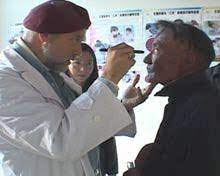Marc Lieberman, MD

Marc Lieberman, MD, who served with great distinction as the CPMC Ophthalmology Department Chief of Glaucoma from 1998 to 2019,was also known as an international humanitarian who brought sight to thousands of Tibetans suffering from cataracts.
A graduate of Johns Hopkins University Medical School, he served his residency at the Wilmer Eye Institute, was an Assistant Professor of Ophthalmology at Illinois Eye and Ear, and was a UCSF Glaucoma Fellow with Robert N. Shaffer, MD. He joined Robert Stamper in writing and updating Becker and Shaffer’s textbook on glaucoma in 1989 which was a standard text in the field for many years. A second edition followed 10 years later.
Together Stamper and Lieberman were prolific not only in contributing to peer-reviewed literature but also working cooperatively with SKERI colleagues on novel treatment techniques for the disease. Particularly intriguing was their paper demonstrating success with bleb-needling to revise a failing trabeculectomy as this was not considered routinely as a management option at the time in the eastern part of the US.
Marc Lieberman took over the reins of the glaucoma service after Dr. Stamper left in 1998 to become a professor and Director of Glaucoma at UCSF. Dr Lieberman remained a central figure in glaucoma education for over 20 years. He was a fixture running glaucoma grand-rounds and involving all community-based glaucoma doctors, ensuring they felt part of the team. As a hands-on educator for the residents, Lieberman engaged with them daily in both his office and operating room while continuing generously to help covering resident clinics and clinic cases when needed.
A practicing Jew, he had also became a leader in the lay Buddhist community in the Bay Area, leading in 1989 to an introduction to the Dalai Lama, the spiritual leader of the Tibetan people who wanted to learn more about Judaism. Dr. Lieberman facilitated a dialogue between the Dalai Lama and American Jewish leaders. This relationship influenced Lieberman’s decision to establish the Tibetan Vision Project in 1995 after learning that cataracts are the leading cause of preventable blindness in Tibet partly from the sheer amount of UV radiation existing there.
Dr. Lieberman was one of three recipients of the American Academy of Ophthalmology’s Humanitarian Service award in 2003, nominated for the award by the American Glaucoma Society, in recognition of his establishment of the Tibet Vision Project which is credited with saving the vision of more than 5000 Tibetans.
For eight years Dr. Lieberman donated two months each year to travel to Tibet to oversee each mission and for many years he and his associates provided all microscopes, examination equipment and intraocular lens supplies for more than 15 eye camps throughout central Tibet. He also enlisted the aid of Dr. Melvyn D. Bert, another member of the CPMC faculty, who served as Director of the Lhasa Eye Program.
 The Tibet Vision Project provided further training in the eye-team model for more than 20 surgeons, nurses and technicians at the Tilganga Eye Centre in Katmandu, Nepal. Tragically, the Chinese government was not in favor of his efforts, and he was often harassed at the border, enduring long waits for a visa. In 2008, the Chinese government barred all foreign NGOs from Tibet and his Tibet Vision Project came to an end although there were brief visits allowed in 2009 and 2010.
The Tibet Vision Project provided further training in the eye-team model for more than 20 surgeons, nurses and technicians at the Tilganga Eye Centre in Katmandu, Nepal. Tragically, the Chinese government was not in favor of his efforts, and he was often harassed at the border, enduring long waits for a visa. In 2008, the Chinese government barred all foreign NGOs from Tibet and his Tibet Vision Project came to an end although there were brief visits allowed in 2009 and 2010.
Marc Lieberman’s work endures today through the skilled surgeons and technicians trained in Tibet and the many CPMC residents influenced by his inspirational teaching.
